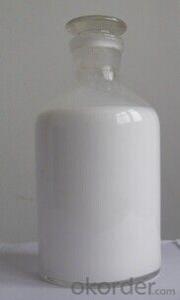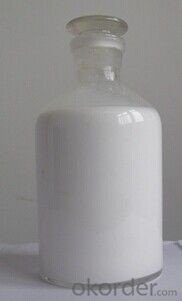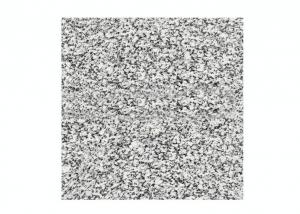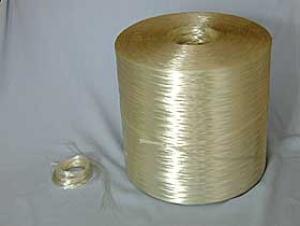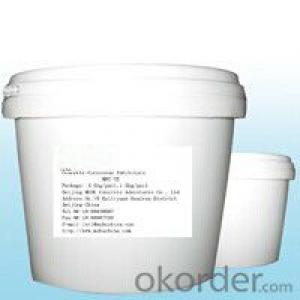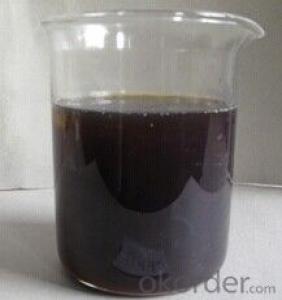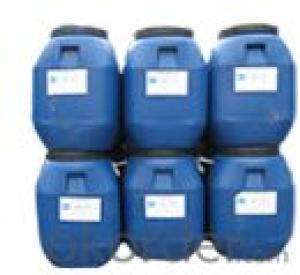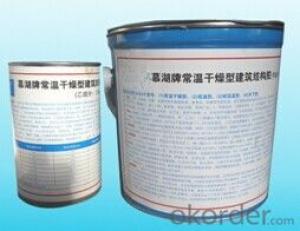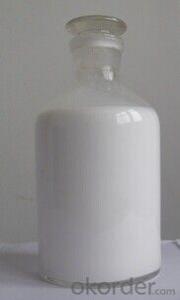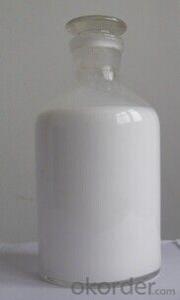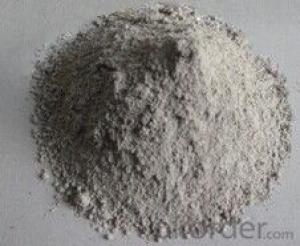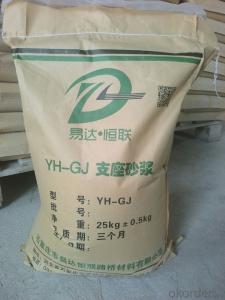Sleeper Mould Release Agent (TS)
- Loading Port:
- China Main Port
- Payment Terms:
- TT OR LC
- Min Order Qty:
- -
- Supply Capability:
- -
OKorder Service Pledge
OKorder Financial Service
You Might Also Like
Sleeper Mould Release Agent (TS)
The product is widely used in processing track sleepers, bridges, pipes, power-line poles, metro, tunnels, bridge-piers, cylinder cement casts.
APPLICATION METHOD
1. Mixing proportion
1) When the first time using this product, to avoid the mixed mould releasing liquid being contaminated during application period, any dirt inside all the facilities which are used to mix should be completely cleaned including container box, pressure tank, pipeline or spray nozzle. To ensure an average spray, Spray nozzle should be examined regularly. The pressure tank should be cleaned every three months to prevent the concentration of mould release being diluted by the accumulated water inside the tank.
2) Use clean running water to mix the mould release. In high temperature season, add running water directly to mould release agent according to recommended ratio. After adequate mixing and totally dissolved, the liquid is ready to use.
3) In winter or cold weather, heat three quarter of needed water to fifty degree by steam (the steam will generate one quarter of condensed water in the heating process), then add mould release agent at required ratio. Fully stirred, the liquid will be ready to use.
Notes, when mixing mould release liquid, it is prohibited to directly mixing it with steam. Leakage and dropping should be avoided too.
Recommendation: If possible, a low-speed agitator may be added to the mixing cabinet. Keep it stirring constantly. In this way, the effective ingredient in the mould release liquid will be used better. Time and effort will be saved and water proportion will be increased.
4) Water proportion: Initially, the ratio can be 1:2 (one kilogram mould release agent against two kilogram water). Then according to the cleanness and smoothness of the mould used, the water proportion can be increased to 1:2.5, 1:3, 1:3.5, 1:4.
5) When using this product for sleeper with pre-buried iron block installation, the water application ratio should be controlled less than 1:1.5.
2. Spraying method
1) New moulds or moulds with formed scale should be de-oiled or cleaned. For moulds rusted seriously should be polished, de-rusted, and cleaned. In such way it takes shorter time for mould release agent to moist the mould, and the appearance of sleeper won’t be affected.
2) The cold mould should be preheated prior to using. Cold mould without preheated should use less water in order to increase the concentration of mould release liquid, and to prevent the mould from sticking.
3) To achieve a mist spraying effect, before starting, ensure the pressure in the pressure tank not lower than 0.4MPa.
4) To ensure best spray, the spray nozzles (four pieces will be ideal) should to be adjusted to make sure the position of spray nozzles, the spray angle match the position of mould to be sprayed. After sprayed, if there is uneven spray or spotted spray on the side of the mould, manually make-up brushing is necessary. If there is some accumulated liquid on the bottom of the mould, use brush to spread the liquid to the sides of the mould to prevent the appearance of the sleeper being affected.
CHARACTERISTICS
1. Visual appearance: ivory-white with slight fragrance, fine texture like fresh milk
2. High purity and grease content, high temperature resistance, low freezing point, inflammable.
3. Good anti-corrosive, stable quality, anti-oxidation. Able to catalyze water molecule.
4. Easy to use, no pollution, no poison, clean and sanitary.
According to the test report, it is non-explosive, non-oxidation, inflammable, non-corrosive, non-poisonous, and non-radiation.
ADVANTAGES
1. Effective mould lease: it keeps the concrete products original color and reduces bubbles. It also covers up the bubbles and air holes. Compared with oil release, it reduces two thirds holes and bubbles on the same area to make the s surface smooth and neat
2. Effective rain-proof: with the isolation layer formed, there is no effect from rain.
3. No corrosion and contamination to the surface of concrete, mould, rubber sealant and rubber shoes.
4. After mould released, there is few dirt and sand on the mould, which makes it easy to clean. The character of corrosion - inhabitation to metal mould can keep metal brightness, save cleaning effort, and extend mould service life. Under urgent condition, it has high efficiency. Mould releasing, cleaning, spreading and spraying, setting up can be operated simultaneously.
5. Easy to mix with water and easy to use. After spraying or brushing on the mould, when the isolation layer is formed and it is ready to cast the concrete.
6. Cost-effective. The cost is 1 to 2 times lower than using oil and other release product.
STORAGE
The product should be stored closely and not to be exposed under sun and rain. Quality warranty is 3 years. If no storage condition on the construction site, it should be sledded and ventilated in summer. In the cold region, anti-freezing measure should be taken. For example, keep it in storage room with heating system or curing place in sleeper workshop
TECHNICAL REQUIREMENT AND TESTING PARAMETERS
The testing standard is for mould release agent produced from crude oil after fading the color with white earth and mixed with catalyst, preservative, anticoagulant and anti-oxidation.
Testing Item | Quality index | Testing method | |
Visual appearance | ivory-white paste | visaually | |
color | ivory-white | visaually | |
texture | fineness | visaually | |
odour | nonirritant | visaually | |
kinematic viscosity (V40) | (cst/s) | 17-23 | GB/T265 |
Solidification point0C | No lower than | -100C | GB/T510 |
PH Value | (PH value) | 7—8 | GB/T259 |
Grease content | % | TF-7B≥85 | GB/T512 |
stearic acid value | (mg KOH/g) | ≥1.9 | GB/T264 |
Corrosion inhibitation: (room tempreture, distilled water,24h,1 grade C.I) | 9% density | Singal layer without rust | SH/T0080 |
Surface tension | Dyh/cm | ≤60 | GB/T6541 |
Resistance to elevated temperatures | No melting to isloation layer | 900C | Curing under elevated tempratures |
- Q: Have you heard of waterproof building materials? What are the characteristics of who
- Structural materials include wood, bamboo, stone, cement, concrete, metal, brick, ceramic, glass engineering plastics, composite materials, etc
- Q: Do the wall waterproofing can be directly on the brick brush on a layer of waterproof material on it
- Can be ah, but in general are rafting spoiled slander diarrhea oblique riveting is done on the concrete, in fact, there are some tiles waterproof role, the late seepage of the words will be outside the brush waterproof paint, are generally used transparent glue, recommended Dragon wall waterproof transparent plastic, before the seepage used to the past few years will not change color, does not affect the decorative effect.
- Q: In accordance with the instructions on the waterproofing agent package with a high proportion of sand but the decoration master said that is not very puzzled more
- Do a good job to fight forging toddler pedal Bang Quan burst water to use polyurethane and polypropylene you that is a high-grade cement, but one year will leak leh hh try it
- Q: What is the difference between the insulation mortar and the ordinary mortar per square meter?
- Insulation mortar is used to enhance the insulation effect of a special mortar, in different construction projects, there are different design thickness, thickness of different prices per square meter is different
- Q: What is the difference between cement, plaster and concrete and what are their characteristics? Google did not.
- First of all you want to know what is concrete? (Concrete, referred to as "concrete" (refers to the rods of the red bar to pay a thick poem rape stream tóng) ": refers to the cement material will aggregate into the overall composition of the composite material collectively refers to the term" concrete " With cement as a cementitious material, sand, stone for the aggregate; and water (with or without admixtures and admixtures) by this definition can know that the mortar is a kind of concrete. But the name is different. It is necessary to have water to participate in the process of hardening. It is a chemical reaction. The final product is hydrated calcium silicate lime is a kind of gas hardening material. In the process of hardening to have air to participate in. The composition is mainly carbon dioxide, and it is also a chemical change, and the final product is calcium carbonate.
- Q: Building materials after the test is how to deal with? So much of the steel and other materials, the detection mechanism is how to deal with these materials?
- Related professional senior title; Test engineers with test certificate; 3 8 years or more test work experience 1 Related professional senior titles.
- Q: What is the difference between a waterproofing agent and a waterproof coating?
- Waterproof coating is directly used for the construction of waterproof layer of waterproof slurry, such as the dragon one-component polyurethane waterproof coating directly open cans to form a waterproof layer; waterproof agent is the main field of tattoo fool algae add each other to the concrete, Cement mortar and other materials which increase its waterproof performance of a waterproof additive.
- Q: What are the characteristics of EVB thermal insulation fireproof dry mortar? Guangxi
- low cost: can be directly applied to the dry base surface, leveling layer and insulation layer into one, significantly reducing the overall construction costs, cost-effective
- Q: What is the usual leveling of the ground? By which type of work to complete?
- As long as the basic level can be, and there is not a very good standard at all, in general, also by the tiling or the floor to sell the workers to complete
- Q: What is called a filler base? Is the cement mortar base hard More
- Oh, hard grass is the structure of concrete components, filler material base refers to the soft material of the grassroots, such as furnace enamel who hired to respect the material of the insulation layer, cement mortar for different layers should be calculated separately, not Hard base
Send your message to us
Sleeper Mould Release Agent (TS)
- Loading Port:
- China Main Port
- Payment Terms:
- TT OR LC
- Min Order Qty:
- -
- Supply Capability:
- -
OKorder Service Pledge
OKorder Financial Service
Similar products
Hot products
Hot Searches
Related keywords
